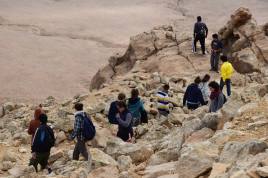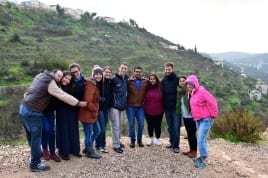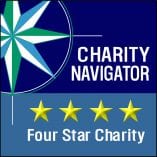Oh Jerusalem
This past month, Jerusalem has become a center of world attention and has been weighing heavily on my mind. The terrorist attacks, including the horrific attack on religious Jews praying in the Har Nof Synagogue, the acts of violence and acts of retribution culminating with the recent attack on the Hand in Hand Arab Jewish School, a symbol of coexistence and dedicated to mutual respect, have left many speechless, hopeless and feeling helpless. It is perhaps no coincidence that at Ben-Gurion Airport, on my way to the US for an end of the year fundraising mission, I bought a copy of Yossi Klein Halevi’s book Like Dreamers about the Israeli paratroopers who as the subtitle states, reunited Jerusalem and divided a nation. Jerusalem has the potential to not only unite the people of Israel but to become a model of cooperation between Israelis and Palestinians. Can we find a way to satisfy our needs to express national sovereignty, jointly protect the rich religious heritage of the eternal city, provide safety, security and dignity to all its residence and learn to respect each other’s difference while celebrating our diversity? It was with these questions that a group of Israeli, Palestinian, Jordanian, European, American and Moroccan Arava Institute students visited the Holy City during the two day Peace-Building and Environmental Leadership Seminar. Our students were exposed to the mosaic of views surrounding the contentious relations between Palestinians and Israelis, learned about each other’s historical tragedies and current attempts to reconcile differences through dialogue. Hopefully, this trip and the Peace-Building and Environmental Leadership Seminar provides our students with the in depth knowledge and familiarity of the complexities of the issues needed in order to be a voice of reason in their home communities, a beacon of hope and a cohort for change.
As I write the introduction to this month’s Director’s Blog, I am receiving reports of a disastrous oil spill from an underground pipe line in the Arava Valley near the Institute. This is a collision between a development project and an energy system based on greenhouse gas producing fossil fuels which has endangered human health on both sides of the borders, wreaked havoc on a unique hyper-arid ecosystem filled with rare endemic species and widened the growing rift between Israel and its neighbor, Jordan. The Institute will issue a separate statement on the environmental damage caused by this catastrophe and how we will be involved in reclamation and remediation of the impact.
Whether we are talking about Jerusalem or the Arava Valley, it is clear that a new generation of leaders are needed to meet the region’s challenges with sustainable and peace-building solutions.
David Lehrer
Negev Trip
In early November, students and interns embarked on an environmental justice themed Negev trip which began in Rahat and ended in Mitzpe Ramon. In Rahat, the group were given a tour of the city followed by a meeting with the mayor and met with two young women who worked at the Rahat Center for young-adults to discuss higher education and 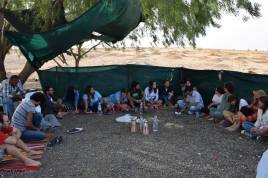
From here, the students went to Al’Arajib Village to meet with Sheikh and hear about the history of the village and their present struggle for recognition. After seeing the village, they drove to visit Moshav Shuva, which is home to one of the students. Here, the group met with members of the moshav, learned about its history and life during this past summer’s war with Gaza. The students ended the day at Holot Makmam, a single family farm near the Ramat Hanegev Regional Council.
The following morning, students met with the owner of the farm, Rodni, and learned about his peace-building efforts with the nearby Bedouin tribes. Rodni told his story of coming to Israel from South Africa and how he created his farm from recycled materials. Students went on a tour of his farm and were impressed by his homemade biodiesel system.
The group then embarked on a walk where they learned about desert ecology, finally reaching Shizaf, a Jewish settlement waiting for government permission to build. Students then completed the walk to the Regional Council where they spoke with the local government about initiatives in the Negev desert.
The next step of the trip led the students South to Wadi Al Na’am, an unrecognized Bedouin village that is affected by Ramat Hovav, a 5,500 acre industrial site outside of Be’er Sheva. Students toured the village and learned about governmental plans to have the village moved for the safety of its inhabitants. After having lunch at a nearby Bedouin school, the group headed to Ramat Hovav to discuss the environmental effects of the industrial park on the nearby communities. The students continued South to spend the night at Wadi Al Aricha with Salman Sadan who has created a tourism business to promote Bedouin heritage.
The next day, after learning about the bio-gas project in Wadi Al Aricha, students headed further South to Mitzpe Ramon to meet with a community organizer who explained current improvement projects for the city. They ate lunch with two different families in Mitzpe Ramon before finishing the trip with a hike down the Mitzpe Ramon Crater with a geologist who explained how the crater was created.
At the end of the crater, students reflected on the trip, discussing the importance of the relationship between the environment and the people living in it. The trip provided a better understanding of the struggle between the traditional Bedouin culture and the role of the government in regulating land use in the Negev desert.
Submitted by Antonia Bacigalupa Albaum and Antoine Lucic
Israel Ride

Submitted by Melanie Nakashian

Truman Institute Conference
On November 10th, The Harry S. Truman Research Institute for the Advancement of Peace at the Hebrew University of Jerusalem hosted a conference marking 20 years since the peace treaty between Israel and Jordan. Among the speakers were United States Ambassador to Israel Daniel B. Shapiro and Israeli Ambassador to Jordan Daniel Nevo who also addressed the current complications in relations between the two countries and the critical nature of the status of the Temple Mount in Jerusalem.
Being one of the central organizations committed to regional peace, the Arava Institute was glad to take part in the conference, showcasing its joint Israeli-Jordanian projects and years-long collaboration.
Submitted by Gili Brenner
Desertification Conference

Submitted by Allyza Lustig
Dual Narratives Peace-Building and Environmental Leadership Seminar (PELS) Trip to Jerusalem
Earlier this month, students and interns of the Arava Institute went on its Peace-Building & Environmental Leadership Seminar (PELS) Dual Narrative Trip to Jerusalem and Jaffa. The first stop was Abu Ghoush, an Arab village near Jerusalem which is considered by many to be a place of coexistence. It was at the town’s 
The group then stopped at the abandoned village of Lifta located right outside of West Jerusalem. The village was a casualty of the 1947/48 Arab-Israeli War in which the Palestinian population living there was driven out due to fighting and has not been able to return. The first day of the trip ended with the students meeting and discussing the conflict with Eli Hazan, an Israeli journalist and member of the Likud party. Students were able to voice their opinions and thoughts on both historic and recent events connected with the conflict, and at the same time ask Eli the tough questions that have defined the PELS program.
The second day began with the students taking a guided tour of Yad Vashem, the Holocaust museum in West Jerusalem, followed by a reflection period where everyone was able to process what they saw together. The students next took a guided bus tour of East Jerusalem with Yaniv Mazor from the organization Ir Amim. They drove through residential areas and along the separation barrier, a highly controversial and key symbol of the conflict. During the ride, Yaniv explained the history of what has happened to the area and people of East Jerusalem since the 1967 Arab/Israeli Six-Day War. The tour finished at a lookout point where the students were able to view most of East Jerusalem and the Old City.
The trip ended with a walking tour of the old city of Jaffa, seeing what life is like there today while at the same time hearing about its history from one of the PELS facilitators. The trip ended with a visit to meet some members of System Ali, a culturally diverse hip-hop group focused on bridging the gap between Israeli and Palestinian youth through the power of music. The students took part in a musical exercises that enabled them to express themselves in a relaxed and fun environment.
Though only a two-day trip, the group was able to process various narratives and come away with a deeper understanding of the conflict and its effects on the lives of people every day, no matter what political, national or religious beliefs.
Submitted by Adam Finestone
Profile: Yousef El Miadi
Yousef El Miadi, 25 from Rabat, Morocco, has been studying at the Arava Institute for the Fall 2014 semester, as the Institute’s first Moroccan student.
He graduated in 2013 from Moha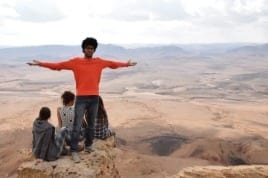
Yousef was attracted to the Arava Institute for the PELS program, its coexistence aspect, and the opportunity to explore his questions about Israel. His experience here has influenced an idea to create an farm in Morocco with environmental technologies and education. He may continue to study here for the Spring 2015 semester, and in the future may pursue a Masters degree in environmental and political issues.
Submitted by Melanie Nakashian

